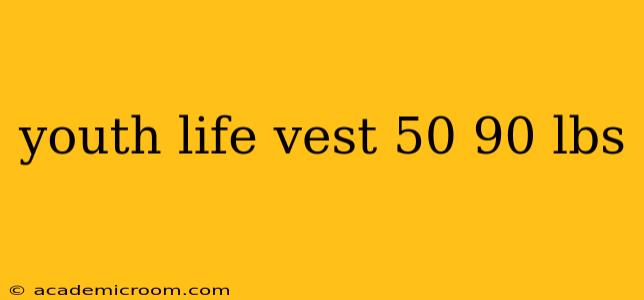Choosing the right life vest for your child is crucial for their safety on the water. With weight ranges varying widely between manufacturers, finding a vest suitable for a 50-90 lb youth can feel overwhelming. This guide breaks down the key factors to consider when selecting a youth life vest in this weight range, answering common questions and ensuring your child is protected.
What Type of Life Vest is Best for a 50-90 lb Youth?
For children weighing between 50 and 90 lbs, a Type III Personal Flotation Device (PFD) is generally recommended. Type III vests are designed for calm waters and offer good buoyancy and comfort. They are less bulky than Type I or Type II vests, allowing for greater freedom of movement, which is important for active children. Always check the manufacturer's weight range to ensure it aligns with your child's weight. Never rely on a vest that is at the very bottom or top of the weight range; opting for one within the middle portion is ideal.
How Do I Know if a Life Vest Fits Properly?
A properly fitting life vest is paramount. A poorly fitting vest can slip or be uncomfortable, reducing its effectiveness. Here's how to check for a proper fit:
- Snugness: The vest should fit snugly but not tightly. Your child should be able to comfortably bend and move their arms.
- Strap Adjustment: Ensure all straps are securely fastened and adjusted. The vest should remain in place even with movement.
- Chin Strap: The chin strap, if present, should fit comfortably under the chin without restricting breathing.
- Buoyancy: The vest should keep your child's head above water when they are face down in the water. You can check this (under supervision) in a shallow, controlled environment like a pool.
What Features Should I Look for in a Youth Life Vest?
Beyond proper fit, consider these additional features:
- Bright Colors: High visibility colors (like bright orange, yellow, or red) make your child easier to spot on the water.
- Reflective Tape: Reflective tape enhances visibility in low-light conditions.
- Comfort: Look for a vest made of comfortable, breathable materials.
- Durability: Choose a vest constructed from high-quality materials to withstand wear and tear.
- Zippers vs. Buckles: Consider which type of closure is easier and safer for your child to use and manage independently.
What's the Difference Between Type II and Type III Life Vests?
While Type III vests are generally recommended for children in this weight range, you might encounter Type II vests. Type II vests provide more buoyancy than Type III vests and are suitable for rougher water conditions. However, they are often bulkier and less comfortable. The decision between Type II and Type III depends on your anticipated water conditions and your child’s comfort level.
Where Can I Find a Youth Life Vest That Fits My Child?
Many sporting goods stores, marine supply stores, and online retailers carry a wide selection of youth life vests. Always check the weight range specified by the manufacturer to ensure a proper fit. Remember to always prioritize safety and choose a life vest that meets the appropriate safety standards.
How Often Should I Check My Child's Life Vest?
Regularly check your child's life vest for any signs of wear and tear, such as rips, tears, or damaged straps. Replace the vest if it shows any signs of damage to ensure continued safety.
Remember, selecting the right youth life vest is crucial for keeping your child safe on the water. Take your time, consider the factors outlined above, and prioritize a well-fitting, high-quality vest that provides optimal protection.
